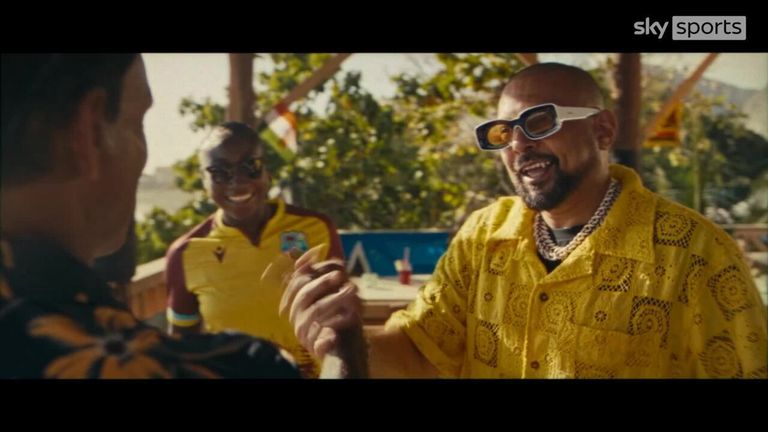With the Men’s T20 World Cup taking place in USA and West Indies from June 1-29, live on Sky Sports, we bring you a jargon buster breaking down some of the terms you may hear, including powerplay, net run-rate, drop-in pitch, DLS, DRS and, potentially, Mankad…

The Men’s T20 World Cup begins this weekend, so get ready for big sixes, stumps being splattered, and a whole lot of cricket jargon.
If you are new to the sport, or just want a refresher on some of the oft-confusing terms, including drop-in pitch and net run-rate, then read our handy glossary (or jargon buster if you will) below.
The tournament starts in the early hours of Sunday morning UK and Ireland time with co-hosts USA meeting Canada in Dallas (1.30am), before the other host nation, two-time champions West Indies, welcome Papua New Guinea to Guyana later in the day (3.30pm).
- Men’s T20 World Cup: Fixtures, dates and schedule
- Stream Sky Sports with NOW – no contract, cancel anytime
- T20 World Cup squads: Jofra Archer picked by England
Anyway, if don’t know your DLS from your DRS or are perplexed as to what a powerplay is, then read on!

Watch the Men’s T20 World Cup, in West Indies and USA, on Sky Sports from June 1 with all 55 matches live
DLS (Duckworth-Lewis-Stern)
This is the method used to calculate the number of runs a team batting second requires if a match is interrupted by the weather and overs are lost. The formula assesses how many overs are remaining and how many wickets the batting side have left with the target adjusted proportionally. Let’s hope for a rain-free event so we don’t need to get into that!
DRS (Decision Review System)
Teams can challenge the on-field umpire’s call of out or not out and bring the third umpire into play if they think a decision, usually lbw or caught, is incorrect. Sides are given two challenges in T20 cricket and retain a challenge if their review is successful or lose it if not. If an lbw decision sticks with the umpire’s call – due to where the ball pitched, hit the batter’s pad or how much of the stumps it was due to strike – the initial decision stands, but the challenging team retain their review.
Drop-in pitch
A pitch prepared away from the venue hosting the game and then ‘dropped in’ ahead of time. The temporary stadium in Nassau, New York, which will host eight games at the T20 World Cup, including India vs Pakistan, has had four drop-in pitches installed.

Image: The temporary stadium in Nassau, New York will have drop-in pitches for the T20 World Cup
Powerplay
During the first six overs of a T20 match – the powerplay – only two fielders are allowed outside the 30-yard circle, theoretically making it easier for the batting side to hit boundaries. For the remaining 14 overs, no more than five fielders are allowed outside the 30-yard circle.
Finisher
The batter charged with trying to clinch victory for his side. Often this can be by smashing sixes and firing fours but manipulation of the field, quick running and a cool head are also key. Ben Stokes showed all these qualities and more as his innings steered England to victories in the 2019 50-over World Cup on home soil and 2022 T20 World Cup in Australia.
Death bowling
Towards the end of an innings (the death), bowlers will usually turn to a variety of deliveries as they look to slow down the flow of runs. Straight yorkers (which pitch at the batters’ feet, making it hard for them to get the ball away), wide yorkers (fired outside off stump, forcing batters to reach for the ball) and cutters (slower deliveries) are frequently seen in this period, with India’s Jasprit Bumrah and England’s Jofra Archer two of the best exponents of those skills.

Former England captains Nasser Hussain and Eoin Morgan look at how Jofra Archer should be used during the T20 World Cup
Jaffa
A term commentators use when a delivery from a bowler is so good that it is almost unplayable. These are what you want to be bowling. Deliveries you don’t want to be bowling are beamers, in which the ball slips out of the bowler’s hand and flies through to the batter around head height without bouncing. These are a complete no-no.
Match-up
An oft-used term with the sea of stats gurus teams have at their disposal to tell them which bowling type a batter is weakest against so that they can plan accordingly. Perceived wisdom is that batters find it harder with the ball spinning away from them, so you usually see an off-spinner bowling to a left-hander and a leg-spinner operating to right-handers. England’s Liam Livingstone bowls both off-spin and leg-spin so is a very handy man to have around.

Grammy Award winner Sean Paul and Soca superstar Kes have joined forces for the official anthem of the T20 World Cup
Net run-rate
This is used to separate teams on the same number of points during a league format, in the way that goal difference does in football. Net run-rate is the average runs scored by a team in an over minus the average runs scored against them. Needless to say, you want your net run-rate to be as high as possible.
Mankad
One of the most controversial dismissals in cricket, which occurs when a bowler runs out the batter at the non-striker’s end before they deliver the ball if that batter has stepped out of their crease backing up. Named after India’s Vinoo Mankad, who removed Australia’s Bill Brown in this fashion in the 1940s, the dismissal is within the laws of cricket but often deemed against the spirit of the game, unless the batter has previously been warned.

During this year’s Under-19 World Cup, New Zealand’s Ewald Schreuder was ‘Mankaded’ by the Afghanistan captain Naseer Khan Maroofkhil
Reverse sweep/scoop
Cricketers play some mind-bendingly funky shots these days. There is still place for the cover drive, cut, pull and agricultural hack over the leg-side but we also see sweeps and scoops, not just of the orthodox variety. Prepare to witness reverse sweeps and reverse scoops aplenty over the next month as batters switch their stance, batting like a left-hander if they are right-handed and vice versa.
Where is Ben Stokes?!
We may hear this phrase if England find themselves in a sticky patch over the next few weeks, with Stokes having opted out of the tournament to focus on getting back to full fitness after knee surgery. England may have enough six-hitters to cope with his absence but, as we have seen countless times over the years, when a run chase gets down to the nitty gritty, Stokes comes into his own. It will be interesting to see who takes on that mantle for England at the T20 World Cup as they look to successfully defend their title.
Watch the T20 World Cup live on Sky Sports between June 1-29. England’s first match is against Scotland in Barbados on Tuesday June 4 (3.30pm UK and Ireland time).
Ad content | Stream Sky Sports on NOW
Stream Sky Sports live with no contract on a Month or Day membership on NOW. Instant access to live action from the Premier League and EFL, plus darts, cricket, tennis, golf and so much more.
Sourse: skysports.com